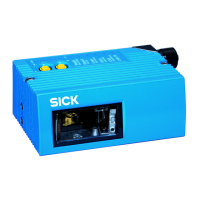
Do you have a question about the SICK Advanced CLV65 Series and is the answer not in the manual?
| Brand | SICK |
|---|---|
| Model | Advanced CLV65 Series |
| Category | Barcode Reader |
| Language | English |
Explains the document's purpose and scope for technical staff.
Defines the intended audience and their required qualifications.
Details the extent of information provided for installation and operation.
Explains symbols used for notices, warnings, and references.
Specifies qualifications required for installation, operation, and maintenance.
Describes the proper application and operation of the device.
Provides essential safety rules for all scanner activities.
Details safe methods for switching the device on and off.
Covers energy requirements and proper disposal guidelines.
Outlines steps to prepare the scanner and software for initial use.
Guides on connecting the scanner to the PC via data interfaces.
Instructions for conducting a basic reading test with the scanner.
Describes scanner setup, including housing types and connections.
Lists the components included in the scanner package.
Details the different available versions and their connections.
Specifies the system requirements for operating the scanner.
Provides a summary of the scanner's capabilities and features.
Explains how the scanner detects and decodes bar codes.
Describes the device's LEDs, buttons, and user interface elements.
Lists the typical steps for installing the bar code scanner.
Covers general requirements and tools needed for installation.
Guidance on choosing the optimal placement for the scanner.
Step-by-step instructions for physically mounting the scanner.
Instructions for installing connection modules and sensors.
Procedure for safely disconnecting and removing the scanner.
Outlines the typical steps for electrical installation.
Details prerequisites like supply voltage and required components.
Explains the various connections and cable types for the scanner.
Covers connecting power supply and data interfaces.
Provides pin assignments and wire colours for various cables.
Lists the main steps for starting up and configuring the scanner.
Details the software used for scanner configuration and diagnosis.
Guides on connecting the PC to the scanner via data interfaces.
Steps for initial setup and optimizing scanner performance.
Explains how to load and reset default scanner settings.
Instructions for fine-tuning the scanner's alignment and performance.
Information on the scanner's maintenance-free operation.
Guidelines for cleaning the reading window and housing.
Instructions for cleaning external sensors and optical parts.
Procedure for ensuring proper function of the incremental encoder.
Steps for removing and replacing the scanner unit.
Categorizes common errors related to installation and operation.
Explains how to interpret LED indicators for diagnosing issues.
Describes how to view and understand the device's status protocol.
Provides contact details for technical support and service.
Detailed technical specifications for the line scanner version.
Technical specifications specific to the oscillating mirror scanner.
Information regarding UL certification requirements.
Graphical representations of depth of field and reading ranges.
Provides detailed physical dimensions for various scanner models.
Lists the additional information contained in the appendix.
Explains how to configure the scanner using command strings.
Provides a guide for calculating bar code lengths for configuration.
Shows physical dimensions for mounting brackets and clamps.
Lists related manuals and product information available.
Defines technical terms used throughout the manual.
Presents the conformity declaration for the bar code scanner.
Illustrates examples of various bar code types and module widths.